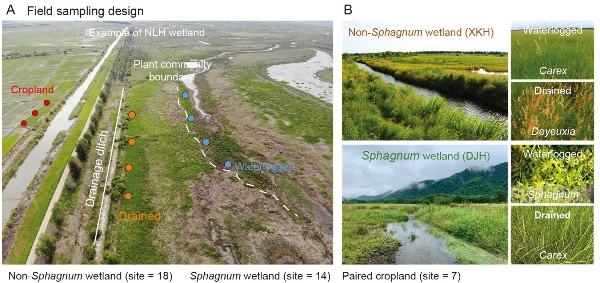Wetlands store 600–1000 Gt of soil carbon and are severely threatened by drainage.
Researchers from the Institute of Botany, Chinese Academy of Sciences (IBCAS) and Bangor University have unraveled an under-investigated mechanism mediating wetland soil carbon response to drainage. The study found that long-term drainage enhanced metallic protection of soil organic carbon (SOC) in herbaceous plant (non-Sphagnum)-dominated wetlands in contrast to (Sphagnum) moss-dominated wetlands due to varied vegetational shifts.
The study was published (online) in National Science Review on May 20.
An established paradigm considers that drainage will greatly decrease the vast SOC reservoir in global wetlands. Yet drainage may also promote the formation of metal-bound organic carbon (bound OC) via ferrous iron oxidation, thereby enhancing SOC accumulation. However, the response of bound OC to drainage in different types of wetlands remains unclear.
To address this knowledge gap, the researchers conducted a nationwide, pairwise survey of drained wetlands across China that had experienced long-term (15–55 years) artificial drainage. The survey involved replicated pairs (n = 4) of waterlogged vs. drained soils in 32 wetlands, including 18 non-Sphagnum wetlands and 14 Sphagnum wetlands. Combined with literature data, this study compared drainage-induced metallic protection of SOC in Sphagnum vs. non-Sphagnum wetlands and revealed the underlying mechanisms related to SOC preservation under shifting wetland hydrology.
The study found that long-term drainage largely increased metallic protection of SOC (i.e., bound OC%) in non-Sphagnum wetlands due to increased reactive metal (hydr)oxides, but consistently decreased bound OC% in Sphagnum wetlands following replacement of the ‘rust engineer’ Sphagnum by herbaceous plants. Additionally, both SOC and bound OC content decreased in most of the examined soil layers in Sphagnum wetlands after drainage, but increased in most layers of the non-Sphagnum wetlands. Improved SOC stock estimates in soil profiles revealed that bound OC increases could compensate for the loss of unbound SOC components in non-Sphagnum wetlands with substantial accrual of reactive metals.
These results suggested that drainage-induced soil carbon stabilization by reactive metals was prevalent in non-Sphagnum wetlands, whereas this mechanism seemed to be weak or absent in the Sphagnum wetlands after drainage. Incorporating this novel mechanism into models will improve prediction of wetland SOC dynamics under shifting hydrological regimes.
This study was supported financially by the National Natural Science Foundation of China.

Overview of sampling design and study sites. At each sampling site, the drained area (~20 m from the drainage ditch) was paired with the pristine waterlogged area nearby (100–800 m from the drained area).
Reference:Liu, C. Z.#, Zhao, Y. P.#, Ma, L. X., Zhai, G. Q., Li X. Q., Freeman C & Feng X. J.* (2024) Metallic protection of soil carbon: Divergent drainage effects in Sphagnum vs. non-Sphagnum wetlands. National Science Review, https://doi.org/10.1093/nsr/nwae178 Contact:
Feng Xiaojuan
Institute of Botany, the Chinese Academy of Sciences
E-mail: xfeng@ibcas.ac.cn
Researchers from the Institute of Botany, Chinese Academy of Sciences (IBCAS) and Bangor University have unraveled an under-investigated mechanism mediating wetland soil carbon response to drainage. The study found that long-term drainage enhanced metallic protection of soil organic carbon (SOC) in herbaceous plant (non-Sphagnum)-dominated wetlands in contrast to (Sphagnum) moss-dominated wetlands due to varied vegetational shifts.
The study was published (online) in National Science Review on May 20.
An established paradigm considers that drainage will greatly decrease the vast SOC reservoir in global wetlands. Yet drainage may also promote the formation of metal-bound organic carbon (bound OC) via ferrous iron oxidation, thereby enhancing SOC accumulation. However, the response of bound OC to drainage in different types of wetlands remains unclear.
To address this knowledge gap, the researchers conducted a nationwide, pairwise survey of drained wetlands across China that had experienced long-term (15–55 years) artificial drainage. The survey involved replicated pairs (n = 4) of waterlogged vs. drained soils in 32 wetlands, including 18 non-Sphagnum wetlands and 14 Sphagnum wetlands. Combined with literature data, this study compared drainage-induced metallic protection of SOC in Sphagnum vs. non-Sphagnum wetlands and revealed the underlying mechanisms related to SOC preservation under shifting wetland hydrology.
The study found that long-term drainage largely increased metallic protection of SOC (i.e., bound OC%) in non-Sphagnum wetlands due to increased reactive metal (hydr)oxides, but consistently decreased bound OC% in Sphagnum wetlands following replacement of the ‘rust engineer’ Sphagnum by herbaceous plants. Additionally, both SOC and bound OC content decreased in most of the examined soil layers in Sphagnum wetlands after drainage, but increased in most layers of the non-Sphagnum wetlands. Improved SOC stock estimates in soil profiles revealed that bound OC increases could compensate for the loss of unbound SOC components in non-Sphagnum wetlands with substantial accrual of reactive metals.
These results suggested that drainage-induced soil carbon stabilization by reactive metals was prevalent in non-Sphagnum wetlands, whereas this mechanism seemed to be weak or absent in the Sphagnum wetlands after drainage. Incorporating this novel mechanism into models will improve prediction of wetland SOC dynamics under shifting hydrological regimes.
This study was supported financially by the National Natural Science Foundation of China.

Overview of sampling design and study sites. At each sampling site, the drained area (~20 m from the drainage ditch) was paired with the pristine waterlogged area nearby (100–800 m from the drained area).
Reference:
Liu, C. Z.#, Zhao, Y. P.#, Ma, L. X., Zhai, G. Q., Li X. Q., Freeman C & Feng X. J.* (2024) Metallic protection of soil carbon: Divergent drainage effects in Sphagnum vs. non-Sphagnum wetlands. National Science Review, https://doi.org/10.1093/nsr/nwae178
Contact:
Feng Xiaojuan
Institute of Botany, the Chinese Academy of Sciences
E-mail: xfeng@ibcas.ac.cn
Feng Xiaojuan
Institute of Botany, the Chinese Academy of Sciences
E-mail: xfeng@ibcas.ac.cn
